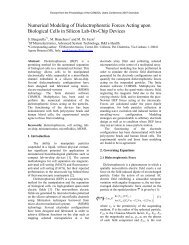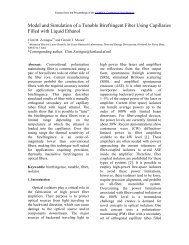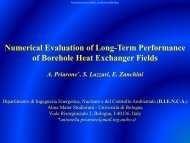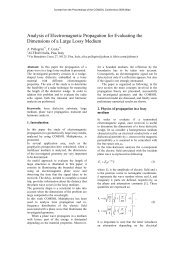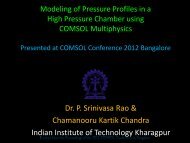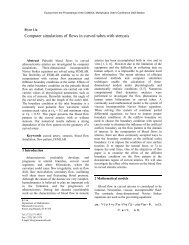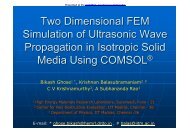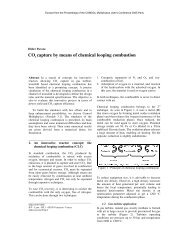Numerical and Experimental Analysis of Natural ... - COMSOL.com
Numerical and Experimental Analysis of Natural ... - COMSOL.com
Numerical and Experimental Analysis of Natural ... - COMSOL.com
You also want an ePaper? Increase the reach of your titles
YUMPU automatically turns print PDFs into web optimized ePapers that Google loves.
Presented at the <strong>COMSOL</strong> Conference 2008 Hannover<br />
<strong>Numerical</strong> <strong>and</strong> <strong>Experimental</strong><br />
<strong>Analysis</strong> <strong>of</strong> <strong>Natural</strong> <strong>and</strong> Mixed<br />
Convection Heat Transfer for<br />
Vertically Arranged DIMM<br />
G. Petrone, G. Cammarata<br />
Department <strong>of</strong> Industrial <strong>and</strong> Mechanical Engineering<br />
University <strong>of</strong> Catania
Outlines<br />
Introduction to DIMM<br />
<strong>Experimental</strong> set-up<br />
<strong>COMSOL</strong> Modelling<br />
Results<br />
Conclusions<br />
<strong>COMSOL</strong> Conference 2008 - Hannover 2
Outlines<br />
Introduction to DIMM<br />
<strong>Experimental</strong> set-up<br />
<strong>COMSOL</strong> Modelling<br />
Results<br />
Conclusions<br />
<strong>COMSOL</strong> Conference 2008 - Hannover 3
Introduction<br />
Electronic devices produce a very important rate <strong>of</strong> specific heat as a by-product<br />
<strong>of</strong> their normal operation.<br />
Among the high power <strong>com</strong>ponents, R<strong>and</strong>om Access Memory modules are one<br />
<strong>of</strong> the more sensitive thermal subsystem <strong>of</strong> an assembled <strong>com</strong>puter.<br />
Cooling<br />
<strong>of</strong> those devices is<br />
always<br />
performed by<br />
mechanical ventilation<br />
systems.<br />
However, the forced air flow is <strong>of</strong>ten<br />
disturbed<br />
by many factors. Cables,<br />
drive bays <strong>and</strong> brackets can<br />
determinate bypass over the memory<br />
<strong>com</strong>ponents, forcing the subsystem to<br />
operate in mixed or natural convection<br />
conditions.<br />
<strong>COMSOL</strong> Conference 2008 - Hannover 4
Introduction<br />
The actually most used memory in desktop Personal Computers is DIMM (Dual<br />
In-line Memory Module):<br />
• 4-16 chip <strong>of</strong> synchrony dynamical memory with r<strong>and</strong>om access (SDRAM) type<br />
DDR [Vdd[<br />
Vdd=2,5 V ] (Double-Data Data Rate) o DDR2 [Vdd[<br />
Vdd=1,8 V]<br />
• Very small (135x30x1,3 mm) Printed Circuit Board (PCB)<br />
• 184 different PIN on both faces <strong>of</strong> the PCB<br />
• It is connected to the mainboard by a specific socket<br />
• It is object <strong>of</strong> JEDEC (Joint Electron Device Engineering Council) st<strong>and</strong>ards<br />
In order to guarantee the reliability <strong>of</strong> these systems, it is strictly necessary that<br />
the memory chip does not over, , during its functioning, the maximum<br />
temperature re<strong>com</strong>mended in the technical documentations <strong>of</strong> constructors<br />
(Micron Technology, 80-110<br />
110°C).<br />
<strong>COMSOL</strong> Conference 2008 - Hannover 5
Introduction<br />
For predictive estimation <strong>of</strong> operative temperature <strong>of</strong> DIMM modules, leading<br />
constructors (Micron, Infineon, …) re<strong>com</strong>mend CFD modelling<br />
<strong>COMSOL</strong> Conference 2008 - Hannover 6
Introduction<br />
The numerical model (<strong>and</strong> so the results carried-<br />
out by simulations) is reliable ?<br />
It is always advisable firstly testing its reliability.<br />
One suitable way to proceed consists in:<br />
‣ setting-up an experimental apparatus reproducing a test section<br />
‣ conducing test experiments on this set-up<br />
‣ some data be<strong>com</strong>e available to be <strong>com</strong>pared with those obtained by using<br />
the numerical model<br />
<strong>COMSOL</strong> Conference 2008 - Hannover 7
Introduction<br />
The aim <strong>of</strong> this study has been <strong>com</strong>paring experimental <strong>and</strong> numerical results<br />
concerning thermal levels <strong>of</strong> operating DIMM<br />
<strong>COMSOL</strong> Conference 2008 - Hannover 8
Introduction<br />
Tools<br />
Infrared thermo-camera<br />
<strong>COMSOL</strong> Multiphysics<br />
<strong>COMSOL</strong> Conference 2008 - Hannover 9
Outlines<br />
Introduction to DIMM<br />
<strong>Experimental</strong> set-up<br />
<strong>COMSOL</strong> Modelling<br />
Results<br />
Conclusions<br />
<strong>COMSOL</strong> Conference 2008 - Hannover 10
<strong>Experimental</strong> set-up<br />
The experimental technique chosen to produce <strong>com</strong>paring data for numerical<br />
results lies on a thermo-graphic investigation on surfaces thermal distribution<br />
<strong>of</strong> Dual In-line Memory Modules during operative conditions.<br />
The experimental apparatus mainly consists in:<br />
‣ a test PC where two 16-chip<br />
memory modules (DDR - 512 MB - 266<br />
MHz) were arranged on<br />
‣ an infrared camera (ThermaCAM(<br />
Flir SC 3000) for detection <strong>of</strong> surface<br />
thermal fields<br />
‣ a laptop PC used for acquisition<br />
<strong>COMSOL</strong> Conference 2008 - Hannover 11
<strong>Experimental</strong> set-up<br />
The experimental technique chosen to produce <strong>com</strong>paring data for numerical<br />
results lies on a thermo-graphic investigation on surfaces thermal distribution<br />
<strong>of</strong> Dual In-line Memory Modules during operative conditions.<br />
The experimental apparatus mainly consists in:<br />
‣ a test PC where two 16-chip<br />
memory modules (DDR - 512 MB - 266<br />
MHz) were arranged on<br />
‣ an infrared camera (ThermaCAM(<br />
Flir SC 3000) for detection <strong>of</strong> surface<br />
thermal fields<br />
‣ a laptop PC used for acquisition<br />
<strong>COMSOL</strong> Conference 2008 - Hannover 12
<strong>Experimental</strong> set-up<br />
The experimental technique chosen to produce <strong>com</strong>paring data for numerical<br />
results lies on a thermo-graphic investigation on surfaces thermal distribution<br />
<strong>of</strong> Dual In-line Memory Modules during operative conditions.<br />
The experimental apparatus mainly consists in:<br />
‣ a test PC where two 16-chip<br />
memory modules (DDR - 512 MB - 266<br />
MHz) were arranged on<br />
‣ an infrared camera (ThermaCAM(<br />
Flir SC 3000) for detection <strong>of</strong> surface<br />
thermal fields<br />
‣ a laptop PC used for acquisition<br />
<strong>COMSOL</strong> Conference 2008 - Hannover 13
<strong>Experimental</strong> set-up<br />
In order to reproduce the most critical heat transfer condition <strong>of</strong> functioning<br />
for the electronic devices, some black panels (red arrows) were employed in<br />
order to shield the memory modules by the forced air-flow produced by<br />
ventilators. The power-pack pack was put outside the case (blue arrow).<br />
<strong>COMSOL</strong> Conference 2008 - Hannover 14
<strong>Experimental</strong> set-up<br />
Frontal black box built around the DIMM also resulted helpful for thermo-<br />
graphical acquisition.<br />
‣ Hot electronic <strong>com</strong>ponents mounted on the<br />
mainboard were hindered by the black panels,<br />
allowing to set temperature range <strong>of</strong> the<br />
acquisition system with thermal values<br />
characteristic <strong>of</strong> the DIMM.<br />
<strong>COMSOL</strong> Conference 2008 - Hannover 15
<strong>Experimental</strong> set-up<br />
During experimental running specific applications were launched on the test<br />
PC in order to load memories by a known electrical power (0.3-0.4 0.4 [W]).<br />
The experimental acquisitions were recorded each 5 seconds, , during a<br />
transient time <strong>of</strong> 3-43<br />
4 hours.<br />
Exceeded this time a stationary thermal behaviour was reached by the<br />
dissipating <strong>com</strong>ponents<br />
<strong>COMSOL</strong> Conference 2008 - Hannover 16
Outlines<br />
Introduction to DIMM<br />
<strong>Experimental</strong> set-up<br />
<strong>COMSOL</strong> Modelling<br />
Results<br />
Conclusions<br />
<strong>COMSOL</strong> Conference 2008 - Hannover 17
<strong>COMSOL</strong> Modelling<br />
The considered physical system is outlined by parallel boards (Printed Circuit<br />
Board) surrounded by air <strong>and</strong> arranging on multiple heat sources (Chip)<br />
<strong>COMSOL</strong> Conference 2008 - Hannover 18
<strong>COMSOL</strong> Modelling<br />
Governing equations for solving thermal <strong>and</strong> dynamical fields read as:<br />
r<br />
Dv<br />
ρ<br />
μ<br />
Dτ = −∇ + r<br />
+ ∇<br />
∂ ρ r + ∇⋅ =<br />
∂τ<br />
r<br />
2<br />
p F v<br />
( ρv<br />
) 0<br />
DT<br />
ρCP<br />
= ∇⋅( λ∇⋅ T)<br />
+ q<br />
Dτ <strong>COMSOL</strong> Conference 2008 - Hannover 19
<strong>COMSOL</strong> Modelling<br />
The energy equation is solved in fluid as well as in solid sub-domains <strong>of</strong><br />
system, by considering appropriate values for thermal conductivity<br />
ty<br />
<strong>COMSOL</strong> Conference 2008 - Hannover 20
<strong>COMSOL</strong> Modelling<br />
Only in chip sub-domains the heat source term is different from zero<br />
<strong>COMSOL</strong> Conference 2008 - Hannover 21
<strong>COMSOL</strong> Modelling<br />
Spatial discretization <strong>of</strong> differential operators made on no-structured <strong>and</strong> no-<br />
uniform mesh<br />
<strong>COMSOL</strong> Conference 2008 - Hannover 22
<strong>COMSOL</strong> Modelling<br />
Influence <strong>of</strong> <strong>com</strong>putational grid has been preliminary studied in order to assure<br />
mesh-independent results<br />
0.165<br />
0.160<br />
U max [m/s ]<br />
0.155<br />
0.150<br />
0.145<br />
0.140<br />
0.135<br />
0 10000 20000 30000 40000 50000<br />
Number <strong>of</strong> elements<br />
<strong>COMSOL</strong> Conference 2008 - Hannover 23
<strong>COMSOL</strong> Modelling<br />
Influence <strong>of</strong> <strong>com</strong>putational grid has been preliminary studied in order to assure<br />
mesh-independent results<br />
0.165<br />
0.160<br />
U max [m/s ]<br />
0.155<br />
0.150<br />
0.145<br />
0.140<br />
0.135<br />
0 10000 20000 30000 40000 50000<br />
Number <strong>of</strong> elements<br />
225600 Degrees <strong>of</strong> freedom<br />
<strong>COMSOL</strong> Conference 2008 - Hannover 24
Outlines<br />
Introduction to DIMM<br />
<strong>Experimental</strong> set-up<br />
<strong>COMSOL</strong> Modelling<br />
Results<br />
Conclusions<br />
<strong>COMSOL</strong> Conference 2008 - Hannover 25
Results<br />
Fluid is propelled by buoyancy force to flow up. Heat is vertically transported.<br />
The integrated circuits arranged in the top portion <strong>of</strong> the modules manifest<br />
higher thermal levels<br />
<strong>COMSOL</strong> Conference 2008 - Hannover 26
Results<br />
Transient analysis: : <strong>com</strong>parison <strong>of</strong> time evolution <strong>of</strong> experimental (magenta<br />
lines) <strong>and</strong> numerical (blue lines) chips mean temperature<br />
<strong>COMSOL</strong> Conference 2008 - Hannover 27
Results<br />
Transient analysis: : <strong>com</strong>parison <strong>of</strong> time evolution <strong>of</strong> experimental (magenta<br />
lines) <strong>and</strong> numerical (blue lines) chips mean temperature<br />
<strong>COMSOL</strong> Conference 2008 - Hannover 28
Results<br />
<strong>Numerical</strong> Vs <strong>Experimental</strong>: : frontal thermal field<br />
<strong>COMSOL</strong> Conference 2008 - Hannover 29
Results<br />
<strong>Numerical</strong> Vs <strong>Experimental</strong>: : frontal thermal field<br />
<strong>COMSOL</strong> Conference 2008 - Hannover 30
Results<br />
<strong>Numerical</strong> Vs <strong>Experimental</strong>: : frontal thermal field<br />
<strong>COMSOL</strong> Conference 2008 - Hannover 31
Results<br />
<strong>Numerical</strong> Vs <strong>Experimental</strong>: : frontal thermal field<br />
<strong>COMSOL</strong> Conference 2008 - Hannover 32
Results<br />
Steady solution: : <strong>com</strong>parison <strong>of</strong> experimental <strong>and</strong> numerical chips mean<br />
temperature<br />
<strong>COMSOL</strong> Conference 2008 - Hannover 33
Results<br />
Models considering imposed air flow rate <strong>com</strong>ing from the bottom surface <strong>of</strong><br />
the outlined air volume have been built<br />
v [m/s]<br />
<strong>COMSOL</strong> Conference 2008 - Hannover 34
Results<br />
Convective heat transfer coefficient have been <strong>com</strong>puted<br />
<strong>Natural</strong> <strong>and</strong> mixed convective heat transfer coefficients have been <strong>com</strong>pared<br />
h<br />
L<br />
Nu<br />
=<br />
1 z y<br />
hb ⋅<br />
z<br />
T<br />
2 2<br />
∫∫<br />
y<br />
1 1<br />
P<br />
∂T dydz<br />
∂x<br />
−T<br />
L<br />
∞<br />
IC Tnat<br />
− Tv<br />
= 0.1<br />
%<br />
T<br />
nat<br />
T<br />
nat<br />
− Tv<br />
= 0.2<br />
%<br />
T<br />
nat<br />
Nu<br />
v= 0.1<br />
− Nunat%<br />
Nu<br />
nat<br />
Nu<br />
v= 0.2<br />
− Nunat%<br />
1 1.59 3.25 12.52 32.32<br />
2 1.68 3.34 13.52 35.54<br />
3 1.75 3.59 15.59 39.81<br />
4 1.83 3.89 20.48 48.80<br />
5 2.53 5.27 25.79 47.04<br />
6 3.20 5.81 26.76 47.38<br />
7 3.89 5.86 30.20 54.42<br />
8 4.02 5.30 50.81 85.19<br />
9 1.58 3.23 17.42 34.74<br />
10 1.67 3.38 26.84 53.77<br />
11 1.73 3.56 34.96 70.68<br />
12 1.81 3.86 45.88 115.72<br />
13 2.52 5.24 80.97 228.95<br />
14 3.24 5.93 101.31 291.41<br />
15 3.99 6.06 192.06 311.35<br />
16 4.11 5.46 197.02 327.19<br />
Nu<br />
nat<br />
<strong>COMSOL</strong> Conference 2008 - Hannover 35
Outlines<br />
Introduction to DIMM<br />
<strong>Experimental</strong> set-up<br />
<strong>COMSOL</strong> Modelling<br />
Results<br />
Conclusions<br />
<strong>COMSOL</strong> Conference 2008 - Hannover 36
Conclusions<br />
‣ This study highlights the opportunity to exploit a numerical approach in order<br />
to simulate thermal <strong>and</strong> fluid-dynamical dynamical behaviour <strong>of</strong> electronic devices.<br />
‣ The paper otherwise underlines the unquestionable importance <strong>of</strong> a<br />
validation step for the numerical model, strictly needed in order to assure<br />
effectiveness <strong>and</strong> reliability <strong>of</strong> the results carried-out<br />
‣ Comparison has been made between DIMM thermal fields experimentally<br />
detected <strong>and</strong> numerically <strong>com</strong>puted<br />
‣ Results show good agreement each other<br />
‣ The validated numerical model has been exploited in order to quantify<br />
heat<br />
transfer coefficients during several operating conditions<br />
<strong>COMSOL</strong> Conference 2008 - Hannover 37
THANK YOU !!!<br />
Department <strong>of</strong> Industrial <strong>and</strong> Mechanical Engineering<br />
University <strong>of</strong> Catania<br />
Authors contact<br />
Address:<br />
D.I.I.M. – University <strong>of</strong> Catania<br />
Viale Andrea Doria, 6 – 95125 CATANIA, ITALY<br />
Phone: +39 095 738 2452<br />
Fax: +39 095 738 2496<br />
E-mail:<br />
Web:<br />
gcamma@diim.unict.it<br />
gpetrone@diim.unict.it<br />
http://www.ing.unict.it<br />
<strong>COMSOL</strong> Conference 2008 - Hannover 38


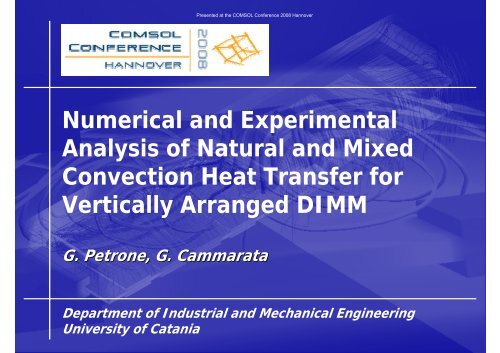
![[PDF] Microsoft Word - paper.docx - COMSOL.com](https://img.yumpu.com/50367802/1/184x260/pdf-microsoft-word-paperdocx-comsolcom.jpg?quality=85)
